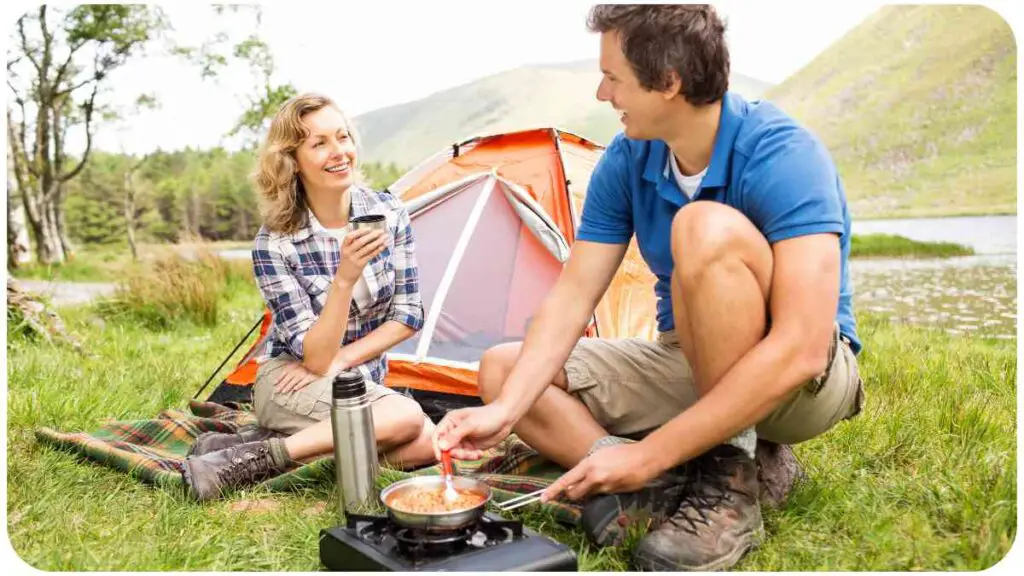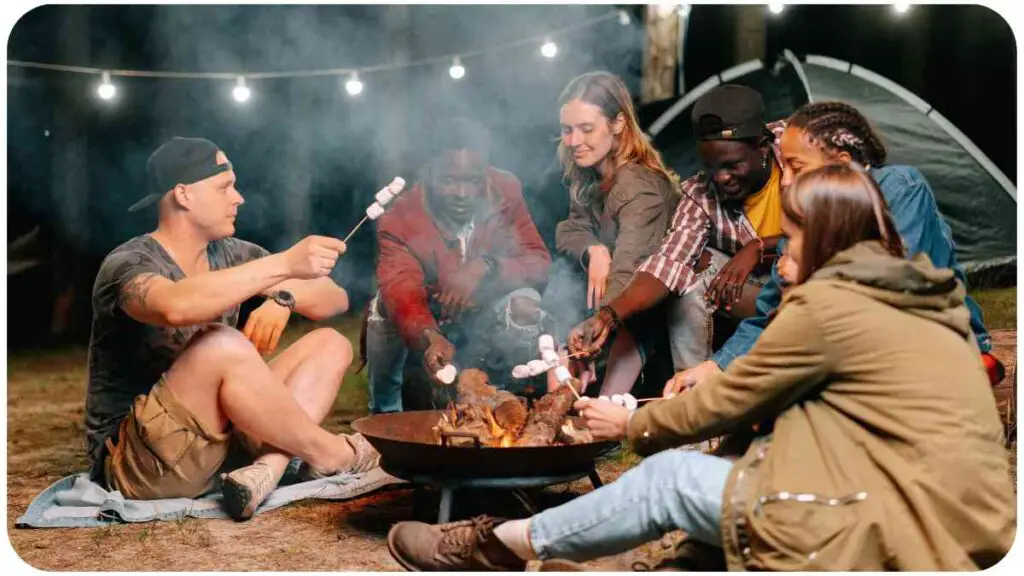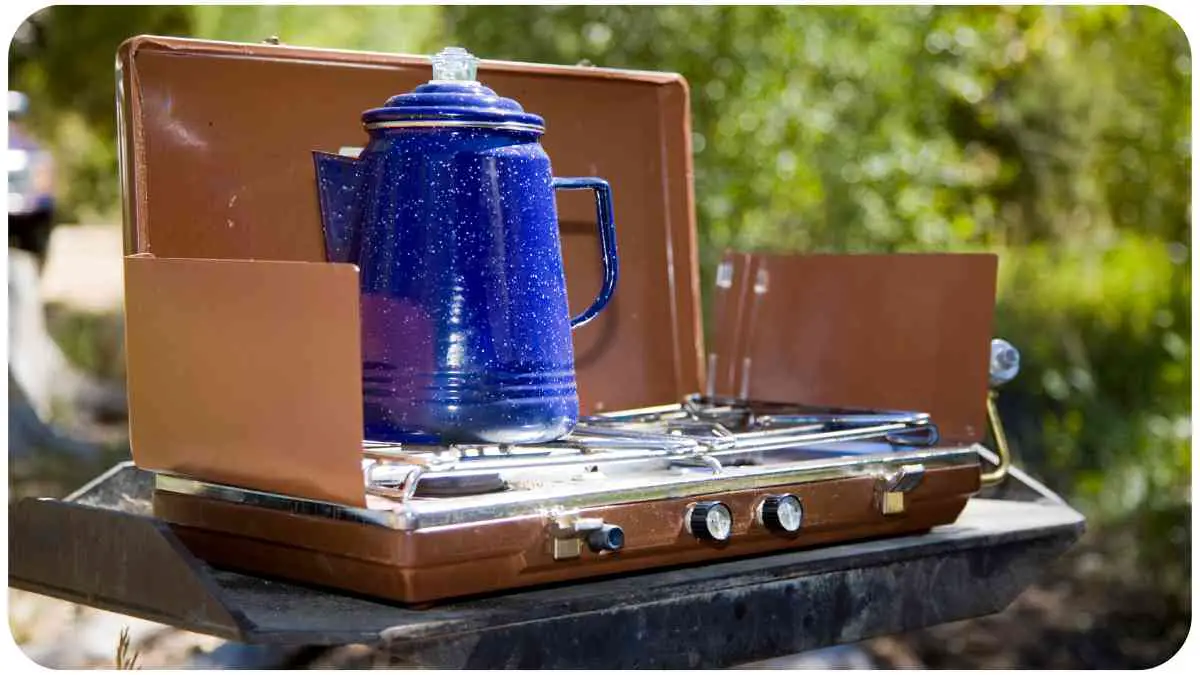Whether you’re a seasoned camper or new to the world of outdoor cooking, getting the most out of your Primus camping stove is crucial for a successful trip. A longer burn time not only saves fuel but also ensures you can savor hot meals, brew your morning coffee, and enjoy the warmth of the fire throughout your camping adventure.
| Takeaways |
| Understand your Primus camping stove and its fuel options. |
| Choose the right fuel type based on your camping environment and trip duration. |
| Prepare your stove and fuel by keeping them clean and well-maintained. |
| Utilize efficient ignition techniques like lighters, ferro rods, or fire starters. |
| Control heat output for optimal cooking and extended burn time. |
| Use wind shields to reduce heat loss in windy conditions. |
| Select suitable cookware to maximize heat efficiency. |
| Prioritize safety by ensuring stable surfaces, ventilation, and fire safety measures. |
| Experiment with recipes and techniques that conserve fuel while cooking. |
| Embrace the camping experience, creating memories around your stove’s warmth. |
2. Understanding Your Primus Camping Stove
Before we delve into the nitty-gritty, let’s understand the basics. Your Primus camping stove is designed for efficiency and convenience. It’s built to work with various fuel types, each with its burn time characteristics. Check your stove’s user manual for specific details about your model.
Unlock the full potential of your BioLite CampStove with expert tips. Enhance outdoor cooking and energy efficiency for a seamless camping adventure.
3. Choosing the Right Fuel Type
Table: Fuel Types and Burn Time Comparison
| Fuel Type | Burn Time | Advantages | Disadvantages |
| Propane | Long | Easy to find, consistent flame | Canister weight |
| Butane | Moderate | Efficient in cold weather | Limited availability in some regions |
| White Gas | Long | High heat output, suitable for winter | Requires priming |
| IsoButane | Short to Moderate | Compact, works well in mild conditions | Lower energy content |
Selecting the right fuel type depends on your camping environment and the duration of your trip. For longer adventures, white gas or propane might be your best bets.
4. Preparing Your Stove and Fuel

Proper preparation sets the stage for an extended burn time. Ensure your stove is clean, free from debris, and in good working condition. Likewise, store your fuel in a cool, dry place to maintain its quality.
5. Efficient Ignition Techniques
Table: Ignition Methods and Efficiency
| Ignition Method | Efficiency Level | Advantages | Disadvantages |
| Match | Moderate | Readily available | Wind can extinguish flame |
| Lighter | High | Wind-resistant | Can run out of fuel |
| Ferro Rod | High | Works in various conditions | Requires practice for consistent sparks |
| Fire Starter | Very High | Reliable in damp environments | Adds weight to your gear |
Experiment with different ignition methods and choose the one that suits your comfort and skill level. Personally, I’ve found a reliable fire starter to be a game-changer.
Overcome hurdles with your MSR stove. Learn quick solutions to common issues, ensuring a trouble-free outdoor cooking experience wherever your journey takes you.
6. Managing Heat Output
Controlling the heat output is vital for both efficient cooking and extending burn time. Opt for a low to medium flame setting for simmering and save the high heat for boiling water or searing.
7. Wind Shields and Their Impact
Table: Wind Shield Effectiveness
| Wind Shield Type | Impact on Burn Time | Advantages | Disadvantages |
| DIY Windscreen | Moderate | Improves fuel efficiency | Requires setup |
| Integrated Shield | High | Built-in, efficient in windy conditions | Stove may be bulkier |
| Windbreak Wall | Very High | Exceptional wind protection | Setup time, takes more space |
Using a wind shield significantly reduces heat loss due to wind, optimizing burn time even in breezy conditions.
8. Cookware Selection Matters
Table: Cookware Types and Heat Efficiency
| Cookware Type | Heat Efficiency | Advantages | Disadvantages |
| Stainless Steel | Low | Durable, even heating | Heavier, longer heat-up time |
| Aluminum | Moderate | Lightweight, quick heating | May warp under high heat |
| Titanium | High | Ultralight, rapid heating | Expensive, less even heating |
| Non-Stick | Moderate | Easy to clean, prevents sticking | Prone to scratches, may reduce efficiency |
Choosing the right cookware impacts how efficiently your stove utilizes fuel. Lighter cookware heats up faster and conserves energy.
9. Regular Maintenance for Extended Life
Regularly cleaning and maintaining your stove ensures optimal performance and extended burn time. Clean out fuel lines, inspect O-rings, and lubricate moving parts according to your stove’s manual.
Elevate your backpacking experience with Deuter. Uncover organization secrets, ensuring your backpack is a well-ordered haven for all your camping essentials.
10. Safety Precautions
Table: Safety Measures for Stove Use
| Safety Measure | Importance Level | Advantages |
| Stable Surface | High | Prevents accidents, ensures even heating |
| Adequate Ventilation | High | Reduces risk of carbon monoxide buildup |
| Fire Extinguisher | Very High | Essential in emergencies, promotes safety |
| Distance from Flammables | High | Prevents accidental fires |
Prioritize safety to have a worry-free camping experience and protect yourself and fellow campers.
11. Cooking Tips and Recipes for Campfire Meals

Table: Campfire Recipes
| Recipe | Burn Time-friendly Tips |
| One-Pot Stews | Simmer on low heat for longer cooking |
| Pasta Dishes | Boil water, then use residual heat |
| Grilled Veggies | Pre-cook veggies to shorten grilling time |
| Morning Oatmeal | Opt for quick-cooking oats |
Experiment with these recipes and tips to create delicious meals without compromising burn time.
12. Personal Anecdotes from the Trail
Throughout my camping journeys, I’ve encountered situations where efficient stove usage made all the difference. On a particularly windy night, my DIY windscreen turned an almost futile cooking endeavor into a warm and satisfying meal.
Conquer any camping terrain by mastering the Coleman tent setup. Follow this step-by-step guide to ensure a hassle-free and comfortable shelter in the great outdoors.
13. Environmental Considerations
Table: Environmental Impact of Fuel Choices
| Fuel Type | Environmental Impact |
| Propane | Low carbon emissions, non-renewable |
| Butane | Low carbon emissions, non-renewable |
| White Gas | Moderate carbon emissions, renewable |
| IsoButane | Low carbon emissions, non-renewable |
Choose your fuel wisely to minimize your ecological footprint while enjoying nature.
14. Staying Warm and Cozy Around the Stove
Aside from cooking, your stove can provide warmth during chilly nights. Gather around it, share stories, and create lasting memories while maximizing its burn time.
15. Embracing the Camping Experience
In conclusion, maximizing burn time on your Primus camping stove is about more than just saving fuel. It’s about enhancing your camping experience, relishing hot meals, and embracing the camaraderie of outdoor life. By understanding your stove, using it efficiently, and making mindful choices, you’ll not only enjoy delicious meals but also forge unforgettable moments around the campfire.
Remember, the outdoors offer boundless adventures, and your trusty Primus camping stove is your companion in savoring every moment. So, get out there, cook up a storm, and let the flames of your stove light up your camping escapades.
Safeguard your water supply with LifeStraw. Discover essential tips on proper usage and maintenance, ensuring clean and safe drinking water during your outdoor adventures.
Conclusion
In the grand tapestry of outdoor adventures, your Primus camping stove is a vital thread that weaves comfort and sustenance into your journey. By following the insights and tips shared in this article, you’re equipped to maximize burn time, conserve fuel, and relish hot meals even in the heart of nature.
From selecting the right fuel to igniting your stove efficiently, managing heat output, and considering safety measures, each step contributes to an extended burn time and an enjoyable camping experience. Remember to choose cookware wisely, prioritize safety, and explore the culinary possibilities that campfire cooking offers.
Personal anecdotes from fellow adventurers and practical advice from a seasoned camping enthusiast enrich this guide, making it a valuable resource as you embark on your next outdoor escapade. By tending to your stove, you’re not just tending to your meals, but also to the warmth of camaraderie and the spirit of exploration.
Further Reading
For more in-depth information on maximizing burn time on your Primus camping stove, consider checking out the following resources:
- Common Questions – Primus US Short Description: Explore Primus US’s comprehensive FAQ section for answers to common inquiries about camping stoves, fuel types, and efficient usage.
- Primus Fuel Consumption – Primus Equipment Short Description: Learn about fuel consumption and efficiency from Primus Equipment’s detailed guide, helping you make informed decisions about fuel usage.
- Stoves 101: How to Get the Most Out of Your Fuel Canisters – MSR Gear Short Description: Dive into MSR Gear’s blog post to gain valuable insights on optimizing fuel canister usage for various camping stoves.
FAQs
How do I choose the right fuel type for my Primus camping stove?
Selecting the ideal fuel type depends on factors such as your camping environment, trip duration, and the stove’s compatibility. Consider factors like burn time, heat output, and availability to make an informed decision.
What are some efficient ignition techniques for my stove?
Efficient ignition methods include using a lighter, ferro rod, or fire starter. These techniques offer reliable ignition even in challenging conditions, ensuring a consistent flame for cooking.
Can I use a wind shield with any type of stove?
Yes, you can use a wind shield with most camping stoves. However, it’s important to ensure proper ventilation to avoid carbon monoxide buildup. A well-designed wind shield can significantly improve burn time by reducing heat loss due to wind.
How can I extend the lifespan of my Primus camping stove?
Regular maintenance is key. Clean your stove after each use, inspect O-rings, and lubricate moving parts as recommended in the user manual. This routine maintenance enhances performance and extends the life of your stove.
Are there any safety precautions I should take while using my camping stove?
Absolutely. Ensure your stove is placed on a stable surface, away from flammable materials. Adequate ventilation is essential to prevent carbon monoxide buildup. Having a fire extinguisher nearby and maintaining a safe distance from the stove are also important safety measures.
Feel free to use this table to quickly grasp the main takeaways from the article. If you’d like to continue or add more tables, please let me know.

I’m Hellen James, and I am a camping enthusiast. I’ve been camping since I was a kid and have always loved it the fresh air, the beautiful scenery, and the great outdoors. In fact, it’s one of my favorite things to do in the summer!


